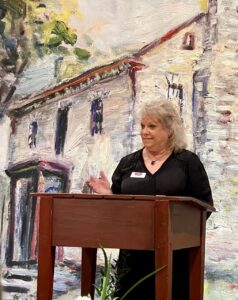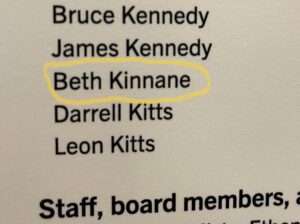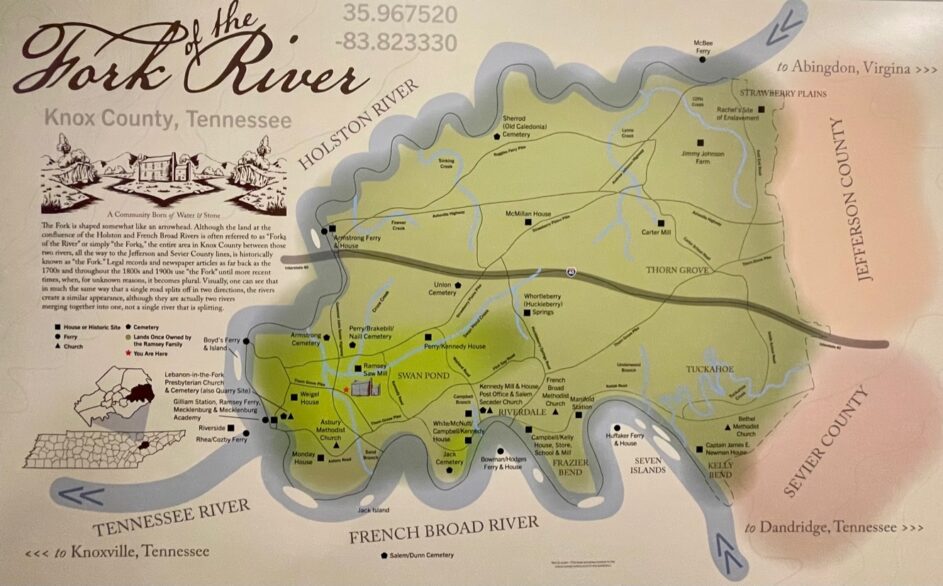A few weeks ago, I reported on the opening of a new exhibit at Historic Ramsey House and its accompanying book further expanding the knowledge of the area we all know as the Forks of the River. As I had done a few articles previously where I interviewed the book’s author, Jan Loveday Dickens, I was asked to write a foreword for it. So here is my small contribution to this considerable piece of local history, reprinted here with permission:
My first introduction to Jan Loveday Dickens was, as often happens for journalists, over the phone. I was writing a history story for KnoxTNToday.com about Lebanon-in-the-Fork, the cemetery and the long-gone church. After a day spent taking pictures on the grounds, I wanted more information than I could readily find online. Upon learning the site was maintained by Historic Ramsey House, I put a call in and was immediately directed to Jan, one of their board members.

Jan Loveday Dickens, president of Historic Ramsey House.
Our conversation went far beyond the realm of my one story. Though we had never met, we found we had much in common. For one thing, as a true daughter of The Fork, she was a graduate of Carter High School, where my father had been a teacher. But we shared a love of art, books, history and stomping around old cemeteries. We made a plan to do just that somewhere out in the future.
We finally met up one day and spent an afternoon exploring the woods around Old Salem Cemetery on Wayland Road. She is determined to identify, one day, the graves of the enslaved that she knows are buried there among the trees. Upon returning to her house for a bite to eat, I couldn’t help but be impressed with the stacks of records, old ledgers, maps, books, you name it.
But one large 3-ring binder was a standout. Jan told me about a time a young Black student told her the history she was teaching wasn’t his history. While she might have been momentarily taken aback, what she wasn’t was insulted or offended. She took that statement to heart, pondered what she might have been missing. Challenge issued, challenge accepted. The digging she did beyond what was found in a history book was contained in that binder and formed lessons in her classroom.
Her persistent research for the stories beyond the official history is the backbone of the new Ramsey House exhibit, A Community Born of Water and Stone. I interviewed her again when I found out about this work in progress. Here is an excerpt from that story:
Dickens said the project looks at the Francis Ramsey family ‘within the context of their community. We’re looking at the histories of other settlers in the area, the women, the children, the Cherokee and the enslaved. The Ramseys did not exist in a vacuum.” – KnoxTNToday 1/12/2022

They even stuck my name on a plaque!
This new exhibit expands our understanding of history. I can think of no one better equipped to pull those broader stories together for this companion book to the exhibit, Forgotten in the Fork. It is not merely an homage to the land from whence she came. If the Fork is a place of water and stone, Jan’s work here is a labor of love and a passion for getting it right.
See previous articles in KnoxTNToday here and here. For more information on Historic Ramsey House go here, where the book is exclusively available in the gift shop, and don’t miss the Ancient Sounds Music Festival coming up this weekend, Sept. 1-2.
Beth Kinnane writes a history feature for KnoxTNToday.com. It’s published each Tuesday and is one of our best-read features.

